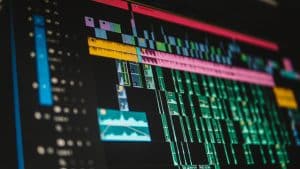One of the most frustrating things that can happen to us as video editors is working with (and ending up) with poor audio. The reasons one might end up with bad audio can range from unfavorable equipment to recording conditions to file corruption. However, while these might be elements we can’t necessarily control as editors, one way we can ensure the final product sounds professional is to normalize the audio in our editing programs. We don’t necessarily even need to be expert sound engineers and mixers to get quality audio from our footage.
So let’s talk about what this means and how you can do this with the various applications you might be using.
What Does “Normalizing Audio” Mean?
Normalizing audio in Non-Linear Editing (NLE) software is a process of adjusting the volume level of an audio clip so that it reaches a maximum or minimum level without clipping. Clipping is when the volume of a clip exceeds a certain threshold and begins to distort. The steps to normalize audio in NLEs vary depending on the application you’re using, but the general process is as follows:
- Select the audio clip you want to normalize
- Navigate to the audio mix or audio effects section of your NLE
- Look for a normalize or gain control option (we’ll go over where to find this)
- Set the normalize or gain level to your desired maximum or minimum level
- If there’s an effect for normalization, apply the normalization effect to the audio clip
- Check the audio waveform, and listen to the clip to make sure it’s at the desired level without clipping
Note that some NLEs may have more advanced normalization options (we’ll get to that in a minute), such as the ability to set a target RMS level or to normalize to a specific dBFS level. It’s important to understand the differences between these options and how they affect the final audio level of your exported video.
The RMS (Root Mean Square) level is a measure of the average power of an audio signal over time. It’s basically a value that represents the overall loudness of the audio clip, and it is often used in audio engineering to determine the appropriate level of gain to apply to an audio signal to reach the correct amount of “loudness.” In general, a higher RMS level indicates a louder audio clip, while a lower RMS level indicates a quieter audio clip.
The dBFS (Decibels Full Scale) level is a measurement of the relative loudness of an audio signal compared to the maximum possible level that can be represented by a digital audio system. In other words, how loud a clip is for the technology and medium it’s being presented from. Understanding audio levels can be a daunting task, so let’s briefly discuss how to approach normalizing your levels in various editing programs.
Normalizing Audio Levels in Premiere Pro
In Premiere Pro, you can normalize audio levels using the “Normalize Maximum Peak to” effect. Here’s how you can apply this effect to an audio clip:
- Select the audio clip you want to normalize in the timeline.
- Right-click the audio clip, and choose “Audio Gain.”
- In the “Audio Gain” dialog box, set the “Gain” value to 0dB. This will set the audio clip’s volume to its maximum without clipping.
- Right-click the audio clip again, and choose Audio Effects.
- From the “Audio Effects” menu, select “Amplitude and Compression,” and then choose “Normalize Maximum Peak to.”
- In the “Normalize Maximum Peak to” effect, set the “Normalize Maximum Peak to” value to your desired decibel level.
- Preview your audio to make sure that the levels are now normalized and that they sound good.
Normalizing audio levels can cause audio to become too loud, resulting in audio clipping. It’s important to be careful when normalizing audio levels and to keep an eye on the audio waveform in the timeline to make sure that it doesn’t go into clipping territory.
How to Normalize Audio Levels in DaVinci Resolve
In DaVinci Resolve, you can normalize audio levels using the “Audio Gain” node. Here’s how you can apply this effect to an audio clip.
- In the “Cut” page, select the audio clip you want to normalize in the timeline.
- Right-click the audio clip, and choose “Add Audio Gain Node.”
- In the “Audio Gain” node, click the “Gain” parameter and enter a value to set the audio clip’s volume to its maximum without clipping. For example, enter 0dB to set the audio gain to its maximum value.
- Right-click the audio clip again, and choose “Add Audio Normalize Node.”
- In the “Audio Normalize” node, set the “Target Level” to whichever level you want.
- Preview your audio to make sure that the levels are now normalized to the desired decibel level.
Normalizing audio levels can cause audio to become too loud, resulting in audio clipping. It’s important to be careful when normalizing audio levels and to keep an eye on the audio meters to make sure that the audio level does not go into the red (clipping) area.
How to Normalize Audio Levels in Final Cut Pro
In Final Cut Pro, you can normalize audio levels using the “Audio Normalization” effect. Here’s how to work with this effect:
- Right-click the audio clip, and choose “Audio Enhancements”
- From the “Audio Enhancements” menu, select “Audio Normalization”
- In the “Audio Normalization” effect, set the “Target Volume” to the desired decibel level — for example, -3dB or whatever you want to set it to. I recommend -2dB for dialogue.
- Click “Ok” to apply the effect to the clip.
- Preview your audio to make sure it sounds good! Voila.
You can also add a “Compressor” effect, which evens out the audio clips levels as a whole. It takes the quieter sounds and raises them up to match the louder sounds within that clip. Within this effect, there are several parameters you can choose from to further tweak the clip, such as Compressor Threshold, Ratio, Attack, Release, Gain, or Knee. While we won’t get into what each of these do, just play around to see how these affect your clip — you’ll find it’s pretty straightforward.
But let’s say you aren’t using one of the major three? Most non-linear editing programs will have a volume-changing functionality that allows you to change the overall decibel level of the audio clip. At this point, it really does just come down to following your gut instincts when judging if something sounds too loud, too soft, or hopefully just right. With past projects, I’ve found that letting someone else listen to the project before you export will give you good insight into whether the audio needs some adjusting.
Cover Image via Videvo
Looking for filmmaking tips and tricks? Check out our YouTube channel for tutorials like this . . .
Looking for more tips and tricks? Check out these articles . . .




